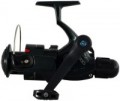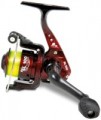Number of bearings
The number of bearings provided in the design of the reel. Bearings are used to reduce friction of rotating parts, which, on the one hand, protects such parts from wear, and on the other hand, reduces excessive effort expended when the handle is rotated. Accordingly, the
more bearings, the more friction units are protected and the better the coil is “optimized”; this parameter is a good indicator of the overall class of the product. At the same time, it is necessary to evaluate different models taking into account their purpose (see "Type").
So, in fly fishing reels, even quite expensive ones, 1 bearing is usually provided — at the point of installation of the drum on a bracket designed for attachment to the rod. This is actually the only significant friction point, so more bearings are simply not required. For multiplier reels, this number varies from 1 for relatively simple options to 6 – 7 for premium ones. And in inertia-free bearings, the number of bearings can reach a couple of dozen.
Drag
The clutch type describes the location of the friction brake mechanism provided in the reel and, accordingly, its adjustment knob.
The friction brake itself is responsible for loosening the reel at a critical force: when the load increases significantly, a properly adjusted friction clutch pits part of the fishing line, preventing it from breaking. But the specific actuation force may differ: some fishermen prefer to loosen the brake as much as possible, allowing the line to slip with rather weak jerks, while others, on the contrary, tighten it, allowing operation only when dangerously approaching the breaking load. And in some situations, you need to change the settings right in the process of playing. The convenience of such a reconfiguration is one of the points that is affected by the type of clutch. In addition, design features may be due to the purpose of the coil. Specific options might be:
—
Front. Friction located directly in the drum, with an adjustment knob on the front of the reel. It is used in inertialess models (see "Type"). It is slightly lighter and simpler in design than the
rear one, making it well suited for light tackle (for example, when fishing in a match). But the adjustment of such a brake, on the one hand, is smoother and more accurate than that of the rear one, on the other hand, it is not so convenient when setting it up on the fly and requires a certain skill.
...In addition, the front clutch is more sensitive to dirt.
— Rear. Another option for placing the clutch in inertialess models. Its name is due to the fact that the drag is located behind the spool, and the adjustment knob is on the back of the reel. Such coils allow you to easily reconfigure the brake right during the fight, and their balance is somewhat more convenient than that of the “front-wheel drive”, because. the design does not have a characteristic "overweight" forward. On the other hand, the adjustment in this case is less accurate, and the coils themselves are somewhat larger and heavier, which makes them poorly suitable for ultralight gear.
— Side. A similar placement of the clutch is typical for multiplier coils — it makes no sense to use other options in such models, as well as to put a side clutch in an inertialess model.Gear ratio
The gear ratio describes the difference in the speed of rotation of the spool and the handle. In reel specifications, it is often written as a ratio of the form x:1, where one indicates 1 turn of the handle, and “x” is the number of turns of the spool in one such turn. To simplify the record, only the first number is indicated in our catalog — for example, the designation 5.2 corresponds to a gear ratio of 5.2: 1.
First of all, the ratio between the speed and the "torque" of the coil depends on this parameter. So, high gear ratios allow you to quickly pull the line, which is important for high-speed wiring — but the power of such reels will be low, and significant efforts on the handle will be required to pull large prey. Conversely, at low numbers, the speed of the line will be small, but you will not have to make significant efforts to move it. In models of the inertialess type (see above), gear ratios of the order of 6 – 7 denote the so-called "high-speed" coils, 4 – 4.5 – "power", and intermediate values \u200b\u200bare universal. Due to their specificity, multiplier models usually have low gear ratios, and the high power of fly fishing reels is due to the fact that the angler rotates the drum directly in them, and the gear ratio is 1.
Spool size
The size of the main spool (drum) of the reel. This parameter directly affects the weight of the coil and its resistance to stress. It uses a symbol in thousands; in order not to go into unnecessary details, we can say that the larger the number in such a designation, the larger and heavier the drum. For different purposes, different sizes will be optimal. So, spools for 2500 – 3000 are considered universal, they can be used for both float fishing and spinning fishing in simple conditions. The smaller size is recommended for light tackle, including ultralight category, and equipment for large and heavy prey (for example, when fishing for carp) may include reels for 4500 – 5000 and
even more.
Spool capacity
The amount of line that can fit on the main spool of a reel with normal winding. It is indicated as a ratio of two numbers, the first of which corresponds to the length of the reeled line in metres, and the second to the thickness in millimetres: for example, the numbers 200 / 0.45 indicate that up to 200 m of fishing line with a thickness of 0.45 mm can fit on the reel.
For different types of fishing, there are recommendations on the optimal value of this parameter; they can be found in special sources. Here we note that the capacity of the spool is indicated exclusively for a smooth fishing line; when using a braided cord, the actual performance may differ markedly.
Reel material
The material from which the base of the coil is made is the part of the structure on which the spool and other mechanisms are installed.
— Plastic. Plastic is inexpensive, lightweight, corrosion resistant and completely immune to salt water. At the same time, this material is easily scratched, its strength is relatively low, and under the action of ultraviolet radiation in some grades of plastic, it is even more reduced. As a result, plastic is used mainly in entry-level coils that are not designed for difficult conditions and high loads. Usually, its quality directly depends on the price of the product.
— Graphite. Most often, this term refers to a relatively simple type of carbon fiber, which has a low cost and can be used even in low-cost-class models. At the same time, with a small weight, graphite is somewhat stronger and more resistant to certain influences than plastic, and therefore is also found in more expensive products. The quality of this material may also vary depending on the price of the coil.
— Carbon. Another type of carbon fiber, higher grade than graphite. Carbon combines high strength, flexural stability and durability under stress with extremely low weight; in addition, it is completely chemically inert (does not corrode) and tolerates ultraviolet radiation, temperature extremes, etc. well. The main disadvantage of this material can be called a high price, due to which it is used mainly in premium models. Also note tha...t carbon requires quite careful handling, because. does not take a hit well.
— Composite. Composites are materials that combine several separate components that are not mixed with each other (unlike, for example, alloys). In coils, this term most often means a combination of the graphite or carbon fiber described above with fiberglass. Fiberglass, despite the name, bears little resemblance to ordinary glass — it is highly flexible and can withstand bumps and falls without any problems; therefore, the combination of this material with carbon reduces the fragility of the latter. And in the "bundle" with graphite, fiberglass slightly increases the strength of the entire structure. The composite base can be found in models of different price categories — this is due to the difference in the quality of the components used.
— Aluminium. The main advantage of aluminium alloys can be called high strength, due to which this material can be found even in "large-caliber" coils designed for strong and heavy production. However, there are simpler options — again, aluminium alloys come in different types, and their characteristics usually depend on the price. In terms of weight, this material, if it surpasses plastic, is not much, and its corrosion resistance is very good. Of the obvious shortcomings, one can only note a rather high (in general) cost.
— Magnesium. Magnesium-based alloys are premium materials. Their main feature is extremely light weight combined with high strength and reliability, which allows you to create powerful and at the same time quite light coils. On the other hand, such products are expensive, and the material itself does not tolerate contact with salt water, and in general its resistance to corrosion is relatively low (which requires the use of special coatings).
Main spool material
The material from which the main spool (drum) of the reel is made. The term "main" is due to the fact that some models can be equipped with several interchangeable drums; see below for details. The materials used may be:
—
Plastic. The most simple and inexpensive option. In terms of strength, plastic can lose to more expensive materials, but for those coils where it is used, this is not decisive: such models are usually not designed for high loads, and a relatively short service life is compensated by a low price. In addition, this material weighs a little — and this means low inertia. At the same time, when buying a spinning reel with a plastic spool, it is worth considering its poor compatibility with braided cords: a rough cord runs along the plastic side with great friction, which negatively affects both the casting distance and the durability of the reel. But with fishing lines, such drums work without problems.
—
Graphite. In most properties, this material is similar to the plastic described above (including poor compatibility with braided cords); it is slightly more durable and durable, as well as, accordingly, higher cost.
—
Aluminium. Aluminium-based alloys used for spools have fairly high strength combined with low weight, moreover, in inertialess reels, they can work normally not only with fishing line, but also with braided cord
...s. With all this, such materials are somewhat more expensive than plastic and graphite, but not so much as to "raise the price to the skies." As a result, aluminium is found in a wide variety of coils, from relatively simple and inexpensive options to powerful premium models.
— Magnesium. The main advantage of magnesium alloys is considered to be very low weight, providing minimal inertia with high strength (surpassing even the aluminium alloys described above). At the same time, note that magnesium is very sensitive to certain corrosion factors, in particular to salt water — some manufacturers directly prescribe in the terms of the guarantee the inadmissibility of contact with it. Yes, and these spools are very expensive. Therefore, this option is used mainly in premium models.Weight
The total weight of the reel (only the device itself, without fishing line). This parameter is important, first of all, for those who select equipment of
the ultralight class — in such gear, the struggle is, as they say, for every extra gram. In other cases, you can not pay special attention to weight.

